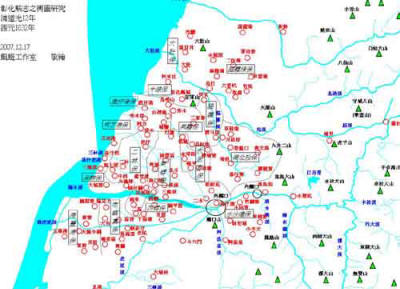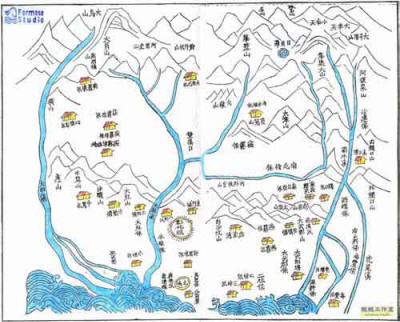
Your Site﹥﹥homepage﹥About Ershui﹥2. Historical evidence
|
|
|
|
|
|
|
|
|
|
|
2. Historical evidence |
||||||||||||||
|
The evidence about the name “Erbashui” can be seen from the literature data: I. Changes in names 1. Earliest: Qing Dynasty, Map of Taiwanese Aborigine Boundaries under the Reign of Qianlong (1760) The name “Erbashui” first appeared in the Qing Dynasty, Map of Taiwanese Aborigine Boundaries under the Reign of Qianlong, in which “Erbashui Village” was marked. 2. Qing Dynasty: 1831 “Chronicles of Changhua County” “Chronicles of Changhua County”:”Erbashui Jetty, one name is Sianghuandu, and connects to Shalian via the water.” This “Chronicles of Changhua County” was published in 1832, and among its names of villages in eastern and western villages in Tungluothere was the name “Erbashui.”
3. Japanese era Beginning in the Japanese period, the administrative name for Ershui was still “Erbashui Village,” and changed to “Ershui” when the village areas were restructured in 1920. II. Source of name 1. Dictionary explanations of the location name (1) Name based on “river shape” Abe Akiyoshi’s Location Names in Taiwan: “Erbashui refers to two rivers flowing in the shape of “eight” in Chinese. This is the conversion of a port name on Jhuoshuei River into the village name. The name of the port was found in the 1764, Revised Taiwan Government Gazetteer. The 1832 “Chronicles of Changhua County” states: “Erbashui Jetty, one name is Sianghuandu, and connects to Shalian (present-day Nantou County) via the water.” This shows that this place was the starting point, there were boats passing over the east of Jhuoshuei River, connecting to the aborigine boundary of Shalian.” Based on the description in this passage, the name of Erbashui was from a port passing, its name was based on its location in the intersection of Jhuoshuei River, forming a Chinese character “eight.” Thus, the origin of “Erbashui” is due to the shape of river convergence. 2. Name based on the water canal in Ershui In Hong Minlin’s Evolution of Old Place Names in Taiwan, he pointed out, “Erbashui Jetty” is not today’s Ershui, but is present-day Hsiangyuanjiao in Xiapingli in northern Chushan Township. The name of “Erbashui” was because its two canals, “Erfengshui Canal” and “Babao Canal.” Draft of the Chronicles of Changhua County: “Ershui was originally named Erbashui, and Erbashui Canal or Erbashui Jetty were converted to Erbashui Village. In 1920, the “ba” was removed, becoming the current name. However, there are also mistakes such as “This township has Shicu Canal and Shiwuchuang Canal, thus it is called Ershui.” According to the description in this passage, the name Erbashui originates from the two canals “Erfengshui Canal” and “Babao Canal” in Ershui Township. At the same time, it refutes the notion of Erbashui Jetty. Based on the actual location, the reason is probably less related to the old name of “Ershui,” “Erbashui.” 3. Name based on the “shape of the canal” Tsung-pao Lai, Ershui – My Homeland: “Babao Canal and Shiwuchuang Canal are shaped like a Chinese character “eight,” which flows separately past the middle of Ershui, thus it got the name of “Erbashui”. According to Tsung-pao Lai, Babao Canal and Shiwuchuang Canal are shaped like a Chinese character “eight,” which flows separately past the middle of Ershui, “Erbashui.” Even though this differs from the canal name previously mentioned, it is still a theory. 4. Section conclusion These perspectives all have the evidence that they focus on, but there are still shortcomings. Abe Akiyoshi and Draft of the Chronicles of Changhua County explain that the name was derived from “Erbashui Jetty,” but investigation of the evidence shows that “Erbashui Jetty” is actually present-day Hsiangyuanjiao in Chushan Township, so it could not be the origin of the Erbashui name. Further, Hong Minlin’s assertion that “Erfengshui Canal” got its name from “Babao Canal” is also quite doubtful. This is because in 1709, the water canal built by Shih-bang Shih et al. was not yet referred to as “Babao Canal,” but rather “Shicu Canal” or “Shih Gong-sheng Canal.” There is evidence for this in Qing Dynasty gazetteers and old documents. Thus, the second view still has problems in terms of time with its evidence, so it cannot be fully believed. At the same time, when Shih-bang Shih was constructing the canal (1709 to 1719), Taiwan did not yet have the “bao” administrative district planning. This administrative region name did not appear until after the reign of Qianlong in Changhua County.
2. Interpretation from the pronunciation Kuo-tien Chen published in article in the magazine Changhua People, and proposed several reasons. (1) “Pak” and “ba” have similar pronunciations Kuo-tien Chen pointed out that under rule by Cheng in the Ming Dynasty, when ancestors traveled from Linqipu (present-day Zhushan) to Ershui, they had to cross Chingshui River and Jhuoshuei River. At the time, they called passing over these two rivers, crossing two “pak” of rivers. “Pak” is similar to the pronunciation of eight “Pat.” Most ancestors who moved here were illiterate, so they wrote the name into “Erbashui”, rather than the “Erfushui” with more strokes and is more difficult to write. 2. “The reading for “Kap” and “ba” are similar Kuo-tien Chen believes that the two rivers referred to by Erbashui should be Chingshui River and Jhuoshuei River. These two rivers converge in Ershui, then flows east out to sea. The Chingshui River and Jhuoshuei River flowing from the mountain was called “Erheshui,” and “he” was pronounced “kap”, sort of similar to the pronunciation of “ba.” Thus, after a long time, this place came to be called “Erbashui”. 3. Named for the shape of two rivers: Chingshui River and Jhuoshuei River. At the same time, Kuo-tien Chen stated, before Chingshui River and Jhuoshuei River converge here, they are shaped like a Chinese character “eight,” thus the place may have been named for the shape. In particular, the two rivers meet and separate again. Thus, regardless of before or after the convergence, they form an “eight” shape, thus the convergence point of the water (at the same time the divergence) was used to name “Erbashui.” Thus, the meaning for being named based on the shape seems to be only on the stream. However, if “Erbashui” really got its name that way, the location with this name should be located near the convergence of two rivers. However, the ancient name of the area is “Bitsaitou,” or the later “Yuanchuan Village.” Thus, there is still doubt over Kuo-tien Chen’s claims. 3. Named for the “Erbashui Canal” Su-fen Chang believed that the name “Erbashui” should be from “Erbashui Canal.” He proposed that the records of Revision of General History of Fujian, Vol. 37, Hydraulics, pointed out the approximate construction time of Erbashui Canal, which were two important connective canals in the hydraulic facilities between 1719 and 1721. Erbashui Canal passed through the villages in Qing Dynasty such as Ershui (present-day Hehe, Shangfeng, Guojun, Wubo, Guanghua, Ershui), from the Jiji Line train warehouse of Ershui, flowing by Wenhua Village, Ershui Street, Guanghua Village, all the way to Erbashui Bridge on Yuanji Road. This canal happens to be the center of Ershui, and the range of the old Erbashui Village. However, at the current time it is impossible to see the complete Erbashui Canal. Thus, past researchers frequently focus on the Babao Canal constructed by Shih-bang Shih et al., overlooking the Erbashui Canal, contemporary of Babao Canal. The old name of Ershui may have come from “Erbashui Canal.” 4. Conclusion However, if the name of “Erbashui” existed as early as 1719, why did it not appear in the local gazeteers until 1760? After 1719-1721, about 40 years passed before 1760, but why is no data on “Erbashui” in literature or interpretations? In addition, Revision of General History of Fujian was written by Chen Shouqi under the reign of Daoguang in the Qing Dynasty. It remains to be known whether there are errors in the year of the evidence. Also, Su-fen Chang cited about “Erbashui Canal,” which was only seen in Revision of General History of Fujian among early data, and was found after the fact; it only had one piece of evidence, which is insufficient to fully prove the assertion. At the same time, As previously stated, in Evolution of Old Place Names in Taiwan, Hong Minlin discussed “Erfengshui Canal,” and Yang Xuxian edited and published the ”Babao Canal Diagram – Also Erfenshui Map” in Taiwan Documents, it remains to be seen whether “Erfengshui Canal” and “Erbashui Canal” are different by one word. Thus, there are many ideas about the origins of “Erbashui,” but they all have problems; this is worth in-depth discussion. As the reason is still a mystery, so perhaps each view can all be considered!!
|
||||||||||||||

